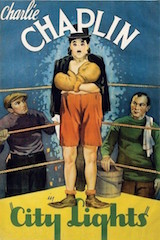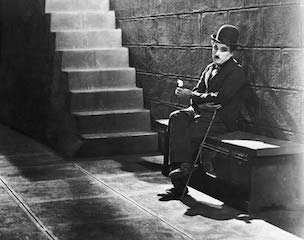 Although I’ve included a few clips from City Lights, I highly recommend watching the entire 87-minute film. It moves quickly, is remarkably approachable (even to those unfamiliar with older and silent films), and available in numerous editions on YouTube, as well as through Criterion’s splendid restoration.
Although I’ve included a few clips from City Lights, I highly recommend watching the entire 87-minute film. It moves quickly, is remarkably approachable (even to those unfamiliar with older and silent films), and available in numerous editions on YouTube, as well as through Criterion’s splendid restoration.
The story of our world is that of a comedy. I don’t mean comedy in the modern sense of the word, a story filled with humor and laughs. I refer to its older meaning, the meaning used by Dante, that of a story ending in joy, rather than grief. Charlie Chaplin’s masterpiece, City Lights, is aware of grief and mirrors this ultimate comedy with a climactic ending of great joy. This understanding is distinctly Christian, for we are to view the world through the lens of the Great Story of All Time, told to us in the Bible.
But it is also a comedy in the traditional sense of the word, being a supremely funny film. Chaplin, repeating his signature role as the Tramp, seems to always arrive in the right place at the wrong time. He sleeps in the arms of a civic statue, awkwardly ruining its grand unveiling. He tries to admire the art in a shop window, only to walk into an open manhole. He wanders out to the docks at night, where a drunk millionaire attempts a suicide right in front of his eyes, avoiding death only after Chaplin’s desperate measures to keep him alive. Finally, after all, these apparent mishaps, a situation occurs that better suits the Tramp, when a blind flower girl, whose beauty smites him, mistakes Chaplin for a wealthy millionaire.
The rest of the film follows Chaplin’s encounters with these two characters. At night, the indebted rich man takes the Tramp out on the town, where hilarious mayhem follows his every move. With a spirit of grace in scenes of ridiculous, frantic circumstances, Chaplin dances with the wrong lady, swallows a whistle down his throat, and mistakes the twirling streamers at a party with his plate of spaghetti. His response is filled with a bashful innocence. In the face of injustices and confusion, the Tramp carries on, smiling and enjoying what is offered him. In his view, he deserves nothing, so anything he gets is a gift.
But during the sober light of day, the rich man, forgetting the previous night’s drama, kicks the Tramp out of his mansion. Chaplin responds by visiting the flower girl’s apartment, where he impresses her with his mistaken wealth and genuine kindness. It is here that he learns of the girl’s debt and its impending consequences, as well as a doctor whose operation could cure her blindness. Desperate to save her from ruin and restore her sight, Chaplin doggedly pursues various employments in an attempt to raise the funds on time. A career as a street sweeper is ruined by his frequent visits to her apartment, and a last minute effort to earn the money in a prize fight results in one of cinema’s all-time funniest sequences, graced by both Chaplin’s nimble feet and his light-footed musical score (composed by the star himself).
In the end, his efforts failed and with the debt’s deadline fast approaching, the tramp runs into the millionaire, drunk again and eager to welcome Chaplin back into his home. The rich man gladly gives Chaplin money for both the girl’s debt and her surgery. The Tramp delivers this gift to the delighted girl, sparing not a single bill for himself. But, in a cruel finale, echoing the frequent role reversals of the story, Chaplin is mistaken for a thief that had robbed the mansion and is locked in jail by the authorities.
Already at this point in the film, there has been more than enough to stir our hearts. The Tramp’s whole-hearted generosity and self-sacrificial love to his beloved echoes, if only dimly, that of our Redeemer’s. His undemanding spirit in the face of confusing circumstances has much to teach us on the believer’s attitude to our changing situations. The way that the rich man, despite his debt to the ragged tramp, regularly fails to recognize him or honor him, reminds me of our frequent condition of spiritual amnesia. But these themes find their climax in the film’s powerful resolution, the most powerful ending I have ever seen.
The Tramp, now released from prison, is completely desolate, a shadow of the man we’ve known up until now. His face is gaunt and his clothes are in rags, leaving him now, at last, truly alone on the city streets, mocked or ignored by all who pass by. He stoops by a window, picking up an abandoned flower. The window happens to belong to the girl, who is now restored to sight and the owner of a respectable flower shop. We learn that she is always seeking the return of her benefactor, wondering if every rich man that comes into her shop is him. Chaplin looks through the window and directly into her face. His face lights up upon recognizing her until he realizes that she has no way of recognizing him.
 The girl assumes that this is just a stranger struck by her beauty. “I have made a conquest!” her title card declares, and she kindly offers him a single flower, along with a coin. But the Tramp just continues to smile out of love, basking in the sight of her face, the petals of ruined flower falling one by one out of his hand. Bashful, he turns to leave, but the girl, dashing out the door, catches his hand and places the coin in it. Suddenly, her look changes to one of clarity and recognition, even horror. Her heightened sense of touch has recognized what her eyes did not. Her redeemer and her lover are standing right in front of her, but he is not who she was expecting. Any former illusions of grandeur are stripped away. She has seen him at last for who he truly is.
The girl assumes that this is just a stranger struck by her beauty. “I have made a conquest!” her title card declares, and she kindly offers him a single flower, along with a coin. But the Tramp just continues to smile out of love, basking in the sight of her face, the petals of ruined flower falling one by one out of his hand. Bashful, he turns to leave, but the girl, dashing out the door, catches his hand and places the coin in it. Suddenly, her look changes to one of clarity and recognition, even horror. Her heightened sense of touch has recognized what her eyes did not. Her redeemer and her lover are standing right in front of her, but he is not who she was expecting. Any former illusions of grandeur are stripped away. She has seen him at last for who he truly is.
“You?” she asks through the title card. The Tramp, his face wound tight with expectation and hope, eagerly nods. Her face falls. Her lover is not a rich man who will sweep her away, but a lowly tramp. Chaplin gestures to the eyes. “You can see now?” asks his title card, a simple question filled with double meaning. Her face is marked with disappointment and sorrow and she confirms. “Yes, I can see now.” The tension is unbearable. Will she accept him for who he is? Will she love him, like he loved her? Everything in the story hinges on this moment. All of the pretending has been stripped away.
Slowly, she takes his hand and clutches it to her breast. For an instant, she smiles; then the camera switches to a tight crop of the Tramp’s face. As doubt departs, his face breaks open into a smile of pure joy, an expression so intense that the screen quickly fades to black and the film ends. To fix our eyes on such joy any longer than what was permitted would be too unbearable this side of heaven.
Do we recognize our Beloved? When He returns, will we see Him for who He is? Or are our eyes blinded to the reality of the joy we are invited to enter, joy like that of the Tramp’s face? City Lights, (aptly subtitled “A Comedy Romance”) is a reorienting film, a film of remarkable clarity for us who need such clarity so desperately. It refreshes us with laughter, reminds us of grace, and restores our vision of joy.


